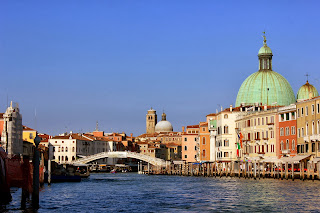1,600 years of civilization is a lot to take in in one day, but I tried my best. After a four-hour drive across Lombardy and the Veneto, Rosanna, Adele and her niece, and I arrived in Venice mid-morning. As it was the closing night of the International Film Festival, there was a bit of a buzz in the air, and on the water.
Arriving in Venice
Nothing quite prepares you for the first-time you set eyes on Piazza San Marco (St Mark’s Square). Described by Napoleon as “the drawing room of Europe,” Piazza San Marco is dominated by the Basilica di San Marco (St Mark’s Basilica), the Campanile and the Palazzo Ducale (Doge’s Palace), and has been giving pigeons a good name since 1815 (when they were introduced by the House of Habsburg). East meets West at the Basilica di San Marco—Venice’s signature architectural wonder was created over a period of 800 years, in its own cosmopolitan image, with Byzantine domes and mosaics, a Greek cross plan, Gothic rosettes and Egyptian marble walls. The Campanile, the Basilica’s 99-metre tall bell tower, has 360-degree views of the lagoon (which we took in later that night), and was from where Galileo Galilei famously showed off his telescope to the Doge of Venice. Speaking of Doges, next-door Palazzo Ducale’s elegant pink-checkered exterior housed Venice’s government for nearly seven centuries, and is now a museum and gallery (that I, unfortunately, didn’t have time to explore).
View of Piazza San Marco
Gondolas, near Piazza San Marco
Basilica di San Marco and the Palazzo Ducale
The Campanile
Piazza San Marco
Rosanna and me, Piazza San Marco
One of my favourite sights in all of Venice is the nearby Ponte dei Sospiri (Bridge of Sighs), which once connected the Palazzo Ducale to the sixteenth century Priggione Nove (New Prisons). It’s named after the sighs that condemned or freed prisoners would emit as they were being led down to their cells, or out from them.
Ponte dei Sospiri (Bridge of Sighs), near Piazza San Marco
After spending some time at the Libreria Acqua Alta, “the most beautiful bookshop in the world”—I would describe it as “the most overwhelmingly beautiful treasure trove” myself—we crossed bridge after bridge after bridge to reach the marble-clad Chiesa di Santa Maria dei Miracoli, and the quiet Campo Santa Maria Nova.
Campo Santa Maria Formosa
Walking around Venice
Walking around Venice
Libreria Acqua Alta, "The Most Beautiful Bookshop in the World"
Libreria Acqua Alta, "The Most Beautiful Bookshop in the World"
Libreria Acqua Alta, "The Most Beautiful Bookshop in the World"
Walking around Venice
Walking around Venice
After checking out the Gothic Basilica Santi Giovanni e Paolo and the skinny Campo San Bartolomeo and checking in to Gelateria Suso (think fig sauce and walnuts swirled into mascarpone ice cream), we reached the marbled Ponte di Rialto and its crowds. From there, we crossed the Campo Cesare Battisti and continued along the Grand Canal to the produce-piled Rialto Mercato and its neighbouring Pescaria—two markets that specialize in all things fresh, local and seasonal (unfortunately, it was getting late in the day, and both were closing up shop).
View from the Salizada Santi Giovanni e Paolo and the Zanipolo
Gelato, Suso Gelatoteca
Ponte di Rialto
View from the Ponte di Rialto
View of the Ca' d'Oro, from the Rialto Market/Pescaria
Afterwards, we hopped on the vaporetto No. 1, a 3.5 kilometre public transportation route that takes locals and tourists along the city's main canal and by most of its spectacularly scenic highlights—if only the same could be said of Toronto’s Yonge-University-Spadina subway line.
View from the Grand Canal
View from the Grand Canal
Ponte di Rialto, from the Grand Canal
View from the Grand Canal
Afterwards, we headed back to Piazza San Marco and up the Campanile, for views of Venice at dusk.
Walking around Venice
Cicheti, in Campo Santa Margherita
View from the Grand Canal
View from the Campanile
View from the Campanile






























No comments:
Post a Comment